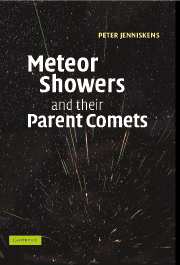Book contents
- Frontmatter
- Dedication
- Contents
- Preface
- Acknowledgements
- Part I Introduction
- 1 How meteor showers were linked to comets
- 2 What is at the core of comets?
- 3 The formation of meteoroid streams
- 4 Meteors from meteoroid impacts on Earth
- 5 Comet and meteoroid orbits
- Part II Parent bodies
- Part III Young streams from water vapor drag
- Part IV Young streams from comet fragmentation
- Part V Old streams and sporadic meteoroids
- Part VI Impact and relevance of meteor showers
- Appendix
- Tables
- Index
- Units and constants
1 - How meteor showers were linked to comets
from Part I - Introduction
Published online by Cambridge University Press: 05 July 2015
- Frontmatter
- Dedication
- Contents
- Preface
- Acknowledgements
- Part I Introduction
- 1 How meteor showers were linked to comets
- 2 What is at the core of comets?
- 3 The formation of meteoroid streams
- 4 Meteors from meteoroid impacts on Earth
- 5 Comet and meteoroid orbits
- Part II Parent bodies
- Part III Young streams from water vapor drag
- Part IV Young streams from comet fragmentation
- Part V Old streams and sporadic meteoroids
- Part VI Impact and relevance of meteor showers
- Appendix
- Tables
- Index
- Units and constants
Summary
When we wish upon a falling star, we appeal to an ancient belief that the stars represent our souls and a meteor is one falling into the hereafter. In Teutonic mythology, for example, your star was tied to heaven by a thread, spun by the hands of an old woman from the day of your birth, and when it snapped, the star fell and your life had ended.
The Greek philosophers were the first to speculate on the nature of things without regard to ancient myths. Especially the world views of Aristotle of Stagira (384–322 BC) in his 350 BC book Meteorology were widely quoted for over two thousand years, embraced by Christian religion, and passionately defended until into the eighteenth century. The Greeks held that all matter in the Universe is made of the elements “earth,” “water,” “air,” and “fire.” Aristotle was of the opinion that shooting stars, because of their rapid motion, occurred relatively nearby in the realm of the element “fire” above the layer of “air” that is now called our atmosphere. He believed that shooting stars were not caused by the falling of stars, but were caused by thin streams of a warm and dry “windy exhalation” (a mixture of the elements fire and air) that had risen from dry land warmed by the Sun. Those exhalations would rise above the moist parts of the atmosphere containing clouds (mixtures of “air” and “water”), into the realm of “fire.” The more and the faster a thing moves, the more it is heated by friction and the more apt it is to catch fire. Hence, when the motion of the heavenly bodies stir the “fire,” the exhalations can burst into flame at the point where they are most flammable. Once ignited, the flame would run along the path of the vapor and thus create a “torch” – what we now call either a fireball or a bolide (βολιδεσ) meaning “thrown spear.”
- Type
- Chapter
- Information
- Meteor Showers and their Parent Comets , pp. 3 - 11Publisher: Cambridge University PressPrint publication year: 2006



